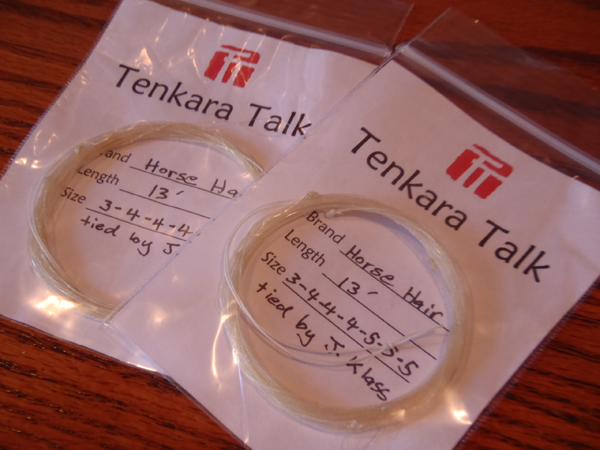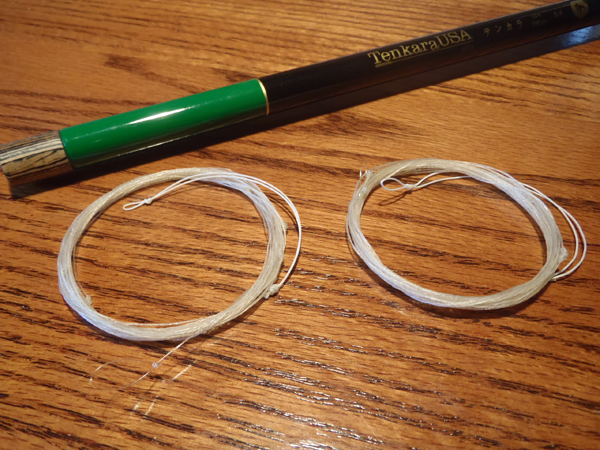For Christmas, my lovely wife got me a horse hair tenkara line kit from Tenkara Bum. I’ve always wanted to try to make my own horse hair line and since I have this whole week off for the holidays, I immediately started furling away. The results were very interesting.
So far, I’ve made two lines. They’re both 13 ft. but with different tapers. When talking about horse hair lines, the taper is defined by the number of strands in each “snood”. “Snood” is an unnecessarily stupid sounding name for “section”. So for example, if a line had a taper of 3-4-4-5-5, the first snood would have a thickness of 3 strands, the next two would have 4 strands, and the last two snoods (forming the butt section) would have a thickness of 5 strands. The snoods are tied together to form the completed line. Since each snood is approximately two feet, a line like this would be approximately 10 feet.
In the picture above, the line on the left has a taper of 3-4-4-4-4-4-4 and is essentially a level line. The only reason the last section is only three strands is to purposely make it the weakest link in the line so that it will break before the the 4-strand snoods and you’ll only lose the tip of the line–saving the majority of it to be repaired.
The line on the right has a taper of 3-4-4-4-5-5-5. This one has a taper and a more powerful butt section. It casts beautifully with my Tenkara USA Ito (the rod I made it for). While some people don’t like to tie lines with five strands for the butt section, I prefer the way it turns over compared to the level line I made.

Furled “snoods” waiting to be tied together into a horse hair tenkara line
Thoughts on DIY Horse Hair Tenkara Lines
Making these lines is incredibly simple. Basically, if you can tie an overhand knot, you can make a horse hair line. Even if you have zero experience in furling (like me), Chris’s instructions are so clear, anyone could follow them. He not only gives you clear step-by-step instructions, but also little tips and caveats along the way that keep you from making mistakes before you make them.
I like the way these lines cast but of course, there is a time investment. You have to be a little patient at first but with a little practice, the process gets quicker and easier. My second line turned out much better than my first and I’m sure my next one will be even better. I’m by no means going to switch over to becoming a horse hair line aficionado, but I can tell you that this is extremely fun and if you like DIY projects, this is a excellent one for when the streams are frozen over or you just want to do something creative besides tying flies. If you’re interested, Karel from Tenkara on the Fly has a great post about his experiences with making a horsehair tenkara line.

Tenkara horse hair lines marked and bagged
Horse hair lines may not be as practical as something like fluorocarbon level lines in some ways, but they sure do cast nicely and while I haven’t done it yet, can imagine the reward of landing a fish on a line you made yourself is just as thrilling as catching a fish on one of your own flies.









I got the kit also with my last order. Haven’t had the time yet to tie any,have had family visiting. Off tomorrow fishing for 3 days and will be using the ones that I purchased tied from Chris. Just love how you can float the line with directional cast dependent on the wind current.
Nice post and recap of what horsehair lines are/should be. Think you put it best in your closing as a fun DIY project…one that is functional to boot. I think they’re simply a cool concept because really, who fishes horsehair these days?
Jason,
I had no idea there were kits out there to make horsehairnTenkara lines. Would you do a picture that shows how each snood is knotted to the other.
Several weeks ago I wrote you about the 17 foot Tenkara rod I picked up in Japan several years ago. Thanks for the advice you gave. I think I will keep the rod as is for now and try dabbibg with it on breezy days on the crick.
Eddie Fast
Hi Eddie, that’s good about the hera rod. I think it will be fun to play with.
Here is a picture showing snoods tied together. It’s basically a surgeon’s knot with some fleximent on it.
Hi Jason,
I received my horse hair kit from Chris, and proceeded to make a 5,5,5,4,4,3 line. It is not the prettiest line you have ever seen, however it does cast very nicely. I have not been to the river with it as yet, it is very light & it affected by the wind. I am not experienced in casting light lines, the only line I have used on my Kasugo is a 15lb level line. I am sure that my tecnique (or lack of) needs just as much work as my furling! I also got a tapered hi vis line from Chris, it is still waiting its turn to be tried.
All of us can improve in many ways. My horse hair lines look terrible but I’m sure they will get better. The great thing about fly fishing is that there is always something new to master–something new to discover and explore. If there weren’t, we would get pretty bored of it pretty fast. Discovery and practice are probably the only things keeping us going.